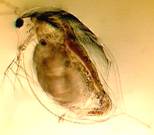|
"Your gateway to
understanding |
Daphnia

- Three major species found in Oneida Lake
- Larger Daphnia species dominate in spring until plankton-eating fish hatch
- Clear carapace makes Daphnia great to study under the microscope
Oneida Lake Daphnia, sometimes called water fleas because of their unique swimming style, are small zooplankton ranging from 0.2 to 3mm in length. Their most distinguishing features are compound eyes, a second set of antennae, and a pair of abdominal setae (hairs). Daphnia are segmented, but the head is fused to the body. In most species, the rest of the body is covered by a carapace (shell) with a gap where the five or six pairs of legs are. The carapace is often translucent, and this makes Daphnia an excellent subject for study under the microscope. Even under relatively low power, it is possible to observe the feeding mechanism working, watch immature young moving in the brood-pouch, observe the eye being moved by the ciliary muscles and even watch blood being pumped round the circulatory system by the simple heart. The heart is at the top of the back, just behind the head. Daphnia are tolerant of being observed live under a cover slip and appear to suffer no harm when returned to open water.
Daphnia live in various aquatic environments ranging from acidic swamps to freshwater lakes, ponds, streams and rivers, and are common in Oneida Lake. Some Daphnia prey on tiny crustaceans and rotifers, but most are filter feeders, ingesting unicellular algae, organic detritus, protists, and bacteria. By beating their legs, Daphnia produce a current through the carapace that brings this food into the digestive tract. The first and second pairs of legs are used to ensure large particles are kept out, while the other sets of legs create the water current into the organism. Swimming is powered mainly by the second set of antennae, which are larger than the first set. The action of this second set of antennae is responsible for the “jumping” motion seen in swimming Daphnia.
Daphnia play a pivotal role in the Oneida Lake ecosystem, serving as food for small fish and as consumers of algae. The large-bodied Daphnia pulicaria (left photo) typically dominates the waters in the spring. This Daphnia grazes on algae, and a large population often leads to very clear lake water. If predation by plankton-eating fish (such as young yellow perch) is high, the large-bodied Daphnia populations decline and the smaller-bodied Daphnia galeata (center photo) and Daphnia retrocurva (right photo) take over. Studies have shown that when the biomass of young yellow perch reaches 18 to 36 lb/acre, these fish depress stocks of the Daphnia pulicaria, and the smaller herbivorous D. galeata and D. retrocurva appear.
To learn more about Dapnia ...
